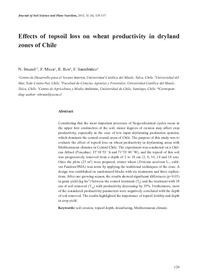Effects of topsoil loss on wheat productivity in dryland zones of Chile
Autor
Meza, F.
Ros-Vera, Rafael
Santibáñez, F.
Brunel, Nidia
Fecha
2011Resumen
Considering that the most important processes of biogeochemical cycles occur in the upper first centimetres of the soil, minor degrees of erosion may affect crop productivity, especially in the case of low input dryfarming production systems, which dominate the central coastal areas of Chile. The purpose of this study was to evaluate the effect of topsoil loss on wheat productivity in dryfarming areas with Mediterranean climates in Central Chile. The experiment was conducted on a Chilean
Alfisol (Pencahue; 35°18`53``S and 71°53`40``W), and the topsoil of this soil was progressively removed from a depth of 2 to 18 cm (2, 6, 10, 14 and 18 cm). Once the plots (25 m2) were prepared, winter wheat (Triticum aestivum L.; cultivar Pandora-INIA) was sown by applying the traditional techniques of the zone. A design was established on randomised blocks with six treatments and three replications. After one growing season, the results showed significant differences (p<0.05) in grain yield (kg ha-1) between the control treatment (T0) and the treatment with 18 cm of soil removed (T18) with productivity decreasing by 35%. Furthermore, most of the considered productivity parameters were negatively correlated with the depth of soil removed. The results highlighted the importance of topsoil fertility and depth in crop yield.
Fuente
Journal of Soil Science and Plant Nutrition, 11(4), 129-137Identificador DOI
dx.doi.org/10.4067/S0718-95162011000400010Colecciones
La publicación tiene asociados los siguientes ficheros de licencia:


